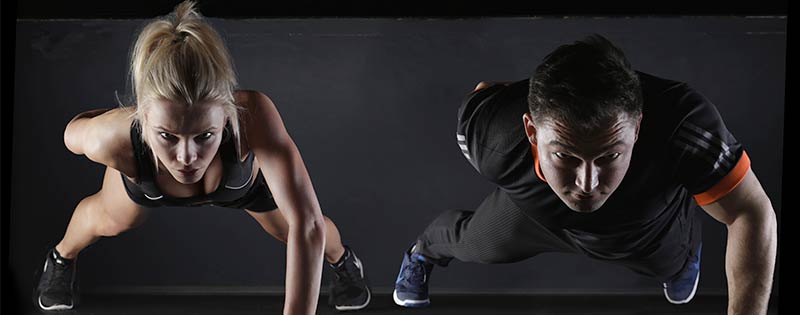by Brent Hearn •
The reopening of movie theaters means the return of superhero flicks. As if we weren’t already feeling the pressure to drop our pandemic-fueled multiple-cookie-a-day habit, now we’ve got ripped, toned physiques on giant celluloid screens reminding us of our decidedly non-superhero bodies.
Take heart. There is good news. You don’t have to pay Marvel money for a marvelous body, and you don’t have to put the “iron” in “Iron Man” to develop strength and overall fitness. There are literally hundreds of different exercises that can be performed using strictly your body weight as resistance and that’s not even counting their myriad variations.
We’re going to focus on a couple of the basics: planks and push-ups There are several keys to performing these movements in a safe, productive manner:
- Aim for slow, steady progress. Try to do too much too quickly, or you may end up with an injury.
- Focus on form. In addition to being a recipe for injury, sloppy movement cheats you of the full benefits of the exercise.
- Give yourself the gift of recovery. Eat right, stay hydrated, and take appropriate rest days.
Planks
At some point, in the battle for abdominal supremacy among sit-ups and crunches, a new player entered the fray: the plank.
The plank is an unlikely superstar. Whereas crunches and sit-ups have a number of moving parts, planks focus on not moving. And while crunches and sit-ups are both “isolation” exercises, the plank is an “integration” exercise, meaning it recruits other muscle groups. A study in the Journal of Strength and Conditioning Research found such integration exercises to be superior in their ability to work the core.
To perform a plank, position your elbows under your shoulders, resting your forearms on the ground (either with your hands in fists or your palms down). You should be on your toes, with your body in a straight line. When your form begins to suffer, stop the exercise; it’s better to do several short sets than a longer one with poor form. There are tons of variations to make the exercise more manageable or more challenging.
Push-ups
The push-up (also called a press-up) is about as classic as it gets. This staple of military recruits and junior high gym classes alike works the chest, arms, core, hips, and legs.
Push-ups may even serve as a predictor of one’s heart health. One study of male firefighters found that participants able to complete more than 40 push-ups were significantly less likely than those who could complete less than 10 to experience a cardiovascular disease event over the following decade.
To perform a push-up, start in a plank position with your hands flat and about shoulder level. Remembering to keep your back straight and your weight evenly distributed, lower yourself to the ground and lift yourself back up. A couple of things to remember: Faster isn’t better, and don’t get discouraged if you can’t do many at first. This is another exercise with numerous variations, so if you need to start on your knees or do incline push-ups against a counter or wall, that’s completely acceptable!
As always, consult with your physician to determine the appropriate fitness routine for your age, current level of fitness, and any underlying health factors.
Sources:
https://www.menshealth.com/uk/building-muscle/a36336906/plank-is-more-effective-than-crunches/
https://www.self.com/story/how-to-do-a-plank
https://www.menshealth.com/uk/building-muscle/a756325/10-best-bodyweight-exercises-for-men/









 ▶︎
▶︎  Why is the Discount Challenge prize amount $15,024? Because that is the average “per-occurrence” fine for Medicare inducements. That’s not $15,024 per patient, that’s not per provider, that’s PER VISIT. Stinks, doesn’t it? To us, the prize amount is worth the investment if we can help our profession better understand proper discounting.
Why is the Discount Challenge prize amount $15,024? Because that is the average “per-occurrence” fine for Medicare inducements. That’s not $15,024 per patient, that’s not per provider, that’s PER VISIT. Stinks, doesn’t it? To us, the prize amount is worth the investment if we can help our profession better understand proper discounting.